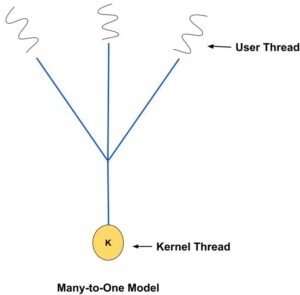Multithreading Models (User-level, Kernel-level)
Modern operating systems are designed to support multiple threads within a single process to allow for concurrent execution. However, how threads are created, managed, and scheduled can vary based on whether the operating system uses user-level or kernel-level threading.
Understanding multithreading models is important to grasp how efficiently a system can handle multitasking and parallel execution within processes.
What Is a Multithreading Model?
A multithreading model defines how threads are mapped and managed by the system—either entirely in user space or with the help of the kernel. It impacts:
- How threads are created
- How they are scheduled
- How they communicate with the operating system
- What happens when one thread blocks
There are two primary categories:
- User-level threading
- Kernel-level threading
Let’s examine them in more detail.
User-Level Threads (ULT)
User-level threads are managed entirely by user-level libraries, without kernel involvement. The operating system only sees one process, regardless of how many threads exist within it.
Characteristics:
- Thread management (creation, scheduling, switching) is handled in user space.
- Faster to create and switch between threads.
- No need for system calls unless accessing hardware or making I/O requests.
- If one thread performs a blocking operation, all other threads in the process are blocked because the kernel is unaware of individual threads.
Advantages:
- Lightweight and fast context switching
- Efficient for CPU-bound tasks and simulations
- Portable across different OS platforms
Disadvantages:
- Lack of true parallelism on multi-core processors
- Blocking system calls can suspend the entire process
- Rely heavily on thread libraries like
pthreadsin user mode
Kernel-Level Threads (KLT)
Kernel-level threads are created and managed by the operating system kernel. Each thread is known to the OS, and the kernel schedules them individually.
Characteristics:
- Thread operations (create, destroy, block, resume) are handled through system calls.
- The OS can schedule different threads on different processors, enabling true parallelism.
- If one thread is blocked, others can continue executing independently.
Advantages:
- Supports real concurrency on multi-core systems
- More stable: One thread’s failure doesn’t affect others as easily
- Efficient for applications with a mix of I/O and CPU tasks
Disadvantages:
- Slower context switching compared to user-level threads
- Requires kernel-mode involvement, which increases overhead
- Less portable across operating systems
Hybrid Approach: Many-to-Many Model
Some modern systems use a hybrid model where many user threads are mapped to many kernel threads. This combines the flexibility of user threads with the power of kernel scheduling.
- Allows multiple user-level threads to run in parallel on multiple processors.
- Reduces blocking issues while maintaining better performance.
Examples include systems that use Lightweight Processes (LWPs) or scheduler activations.
Summary
The choice between user-level and kernel-level multithreading affects performance, scalability, and control over how threads behave in a system.
- User-level threads are efficient but limited by their inability to leverage true parallelism.
- Kernel-level threads provide better performance on multicore CPUs but are more resource-intensive.
- Hybrid models aim to strike a balance between flexibility and efficiency.
Understanding these models helps developers design software that runs efficiently on a wide range of systems—from desktop applications to large-scale servers.
